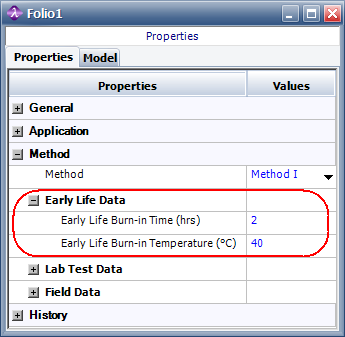

| Related Topics: | ||
For each item in the system hierarchy, the Early
Life Data heading in the Properties panel includes the burn-in
properties used to obtain the early
life factor (also known as first-year
multiplier) described in the Bellcore/Telcordia standards. Burn-in
may be performed at the system or assembly level — represented in Lambda
Predict by a standard item (![]() or
or ![]() ) or block (
) or block ( ![]() or
or ![]() ) — or on the individual component. Therefore, the
factor is calculated separately for each item in the system hierarchy.
To indicate no burn-in, enter a value = 0 in the Early
Life Burn-in Time property.
) — or on the individual component. Therefore, the
factor is calculated separately for each item in the system hierarchy.
To indicate no burn-in, enter a value = 0 in the Early
Life Burn-in Time property.

The early life factor is defined as the ratio of the component's first-year failure rate to its steady-state failure rate. The calculated value of the early life factor is displayed in the Early Life Factor column in the system hierarchy, along with the calculated value of the steady-state failure rate in the Failure Rate (t=INF) column. You can easily obtain the value of a component's first-year failure rate by taking the product of these two values. (To hide or display columns, right-click anywhere in the system hierarchy, and then click Customize Columns to select which columns you want to display. These settings are stored per computer/username on the System Hierarchy page of the Application Setup, so any project that you open on this computer will have the same columns displayed.)
© 1992-2015. ReliaSoft Corporation. ALL RIGHTS RESERVED.